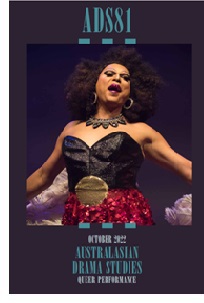Issue 81Fri, 18 Nov 2022
Printable version
Australasian Drama Studies
Issue 81 | October 2022
Table of Contents - Issue 081 (Full Issue PDF)
- Contents
- Editorial: Queer Performance Jonathan Bollen , Alyson Campbelland, Liza-Mare Syron
- Koori Gras: A radical celebration of sparkling defiance – Liza-Mare Syron
- An HIV love story: Jacob Boehme’s Blood on the Dance Floor’s queer and Indigenous revolt – Jacob Boehme, Alyson Campbell and Jonathan Graffam
- Tracing Transitions – Stace Callaghan and Leah Mercer
- A Queer Performance New Wave in Sydney: Inside Club Bent 1995-1998–exploring hybridity and community – Catherine Fargher
- The Future is Now: Queer Utopian Longing and the Utopian Performative in Today x Future in Metro Manila – Ian Rafael Ramirez
- “Show me how you do it down under”: Realness at The West Ball II and the translation of vogue ballroom in Australia – Billy Kanafani
- Theatre as a Space of Resistance and Protest: Queer Politics and Colour of Trans 2.0 – Neethu Das. K and Vellikkeel Raghavan
- “We’ll meet you underground”: transcultural performance practices in queer space and time – Jeremy Neideck, Nathan Stoneham, Younghee Park, and M’ck McKeague
- Birds of A Feather: On Queerness, Performance, The Coming Back Out Ball, and LGBTIQ+ Elders Dance Club – Peta Murray, Adelaide Rief, Marnie Badham, Tristan Meecham, Bec Reid, Lenine Bourke
- A Rainbow in the Age of Covid: Contemporary Queer Theatre in Aotearoa – James Wenley and Nathan Joe
- Reviews
- Contributors
- test
|
|
|
|